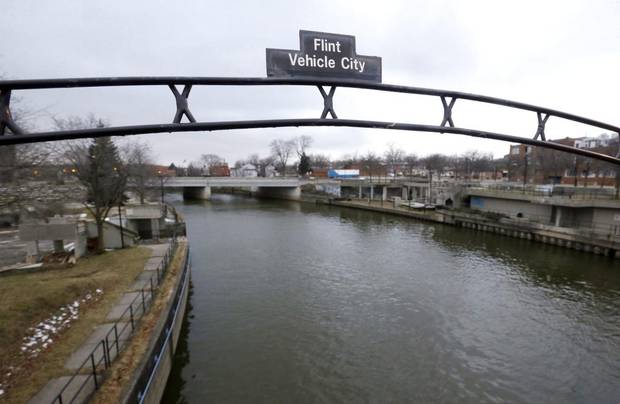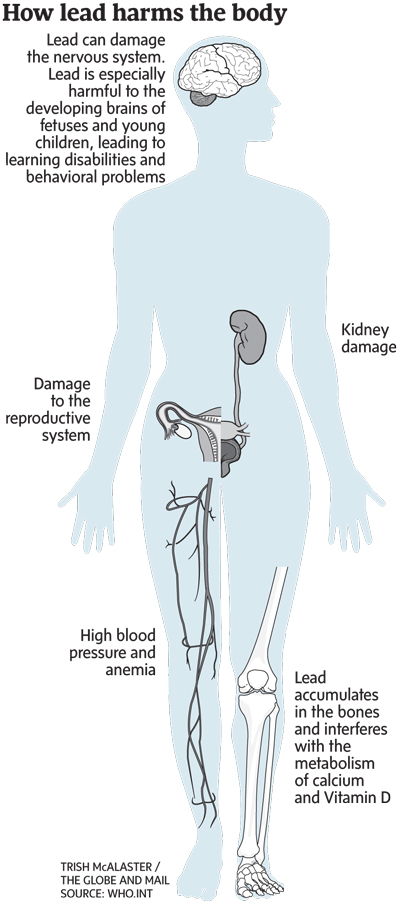
Shanice Ollie washes dishes with boiled bottled water, a process that can take an hour or more, at her home in Flint, Mich., March 5, 2016. Though lead levels in Flint’s tap water have decreased slightly over the last six months, residents are urged to continue using bottled water and filters for drinking, researchers said on April 12.
Brittany Greeson/The New York Times
What surprised Elyse Pivnick weren't the details, even though they were grim: Flint, Mich., a town of 100,000, had been poisoned, its children made sick by levels of lead in the drinking water so high, they exceed the government's definition of hazardous waste.
But as she watched the eyes of the nation turn to Michigan last year, Ms. Pivnick, an environmental health expert who has spent 12 years working on lead-poisoning prevention, realized something else. Shortly before the Flint scandal became public, Ms. Pivnick had worked on a study of lead poisoning in New Jersey. In 11 cities in that state, there was a higher percentage of children affected by lead than in Flint.
"This is not to take a thing away from the debacle in Flint," says Ms. Pivnick, who is the director of environmental health at Isles, a community development organization, "but it is to say that this is a very old problem."
Some of the darkest chapters in the history of American industrialization are written in lead. For the better part of a century, as factories, suburbs and highways transformed the socioeconomic fabric of the country, lead was a central construction and production material. It was added to paint and gasoline; it lined the water pipes. By the time the nation's health agencies finally restricted its use on account of the deleterious effects it has on the minds of children – the harrowing evidence of decreased intelligence, stunted growth, organ damage – lead had already become a central connective tissue in much of the country's infrastructure.
President Barack Obama will travel to Flint today, his first trip there since the tainted water crisis broke last year. He is expected to meet with local residents and give a speech about what the government intends to do to fix a situation that many in the city have called a living nightmare.
But the ongoing scandal in Michigan – a perfect storm of overzealous cost-cutting, administrative negligence and government inaction – has also once more turned public attention in the United States to the question of how to finally remove all the aging, lead-lined infrastructure throughout the country.
The answer to that question is at once straightforward and dauntingly complex. In the case of water pipes alone (the source of only a small fraction of lead poisoning; lead is also often found in house paint) it will likely take decades and hundreds of billions of dollars – money that almost no jurisdiction in the nation is ready to spend, and the timeline all but guarantees there will be more Flint-like disasters before all the lead is finally gone.
The first problem is, nobody really knows what's in the ground.

Adam Murphy bathes his newborn son, Declan, using bottled water, at his home in Flint, Mich., April 9, 2016. Reports of rashes, itchiness and hair loss are widespread, despite assurances from government scientists that they have not found any evidence that the city’s lead-tainted water is unsafe for bathing. Many residents say they are bathing less frequently.
Brittany Greeson/The New York Times
For much of the 20th century, lead water pipes were an integral part of America's suburban expansion. Today, thanks to a labyrinth of overlapping jurisdictions, incomplete record-keeping and sheer complexity, the process of identifying where the remaining lead pipes lay is little more than educated guesswork. Indeed, much of it involves the age of what can be seen – if a house or neighbourhood is older than a certain age, chances are there's lead under the ground.
A recent study by the American Water Works Association estimated that there are about 6.1 million lead service lines in the U.S. today.
"If you consider the cost of removal to be something like $5,000 (U.S.) each, that gives you another $30-billion investment challenge collectively," says AWWA spokesperson Greg Kail.
And that's the optimistic estimate. In March, the ratings agency Fitch estimated that an effort to upgrade the nation's water infrastructure in the wake of the Flint crisis – especially if the situation prompts federal authorities to strengthen safety regulations – could cost more than $275-billion.
In April, 2014, Flint switched its water source from Lake Huron to the Flint River. It switched back in October, 2015. Researchers found that the Flint River water is more damaging to pipes because of high levels of chloride, which is more corrosive. Lead pipes connecting homes to water mains would corrode and leach lead into the water. Soldered copper pipe connections, especially in pre-1986 homes, can contain lead, as well.
Trish McAlaster/THE GLOBE AND MAIL/MLIVE MEDIA GROUP
Where that money will come from is anybody's guess. In another AWWA survey, almost a third of the organization's members said their utilities are struggling to cover the cost of current services. Indeed, the genesis of the Flint debacle was the desire of city officials to switch from the Detroit water system to something cheaper.
But in addition to complexity and cost, there's another, somewhat unspoken hurdle, something else holding back the political will to upgrade the nation's ancient pipes. Many of the communities that suffer the worst effects when things go wrong are similar to Flint in one important way – their residents are usually poor and black.
"It is clear that this could be conceived of and should be conceived of as an issue of environmental racism," says David Rosner, a professor of sociomedical sciences at Columbia University and co-author of Lead Wars, an investigation into lead poisoning in America.
"I don't think there would be a discussion about cost if we were talking about white kids getting meningitis. But we're raising that issue of cost again and again, I think, because it's a poor minority community that has been politically disempowered and has no voice."

This Jan. 26, 2016 file photo shows a sign over the Flint River noting Flint, Mich., as Vehicle City. In proposing a tougher limit for lead in drinking water, Gov. Rick Snyder wants to lift Michigan from the depths of the Flint crisis to being a model for water safety that can help assess whether the current national rules governing lead are too lax.
Carlos Osorio/AP Photo
In the last three decades, the U.S. has made massive strides in limiting lead exposure. Lead lines stopped going into the ground around 1986. The same decade also saw a phase-out of lead in gasoline. In 1991, the Environmental Protection Agency's new Lead and Copper Rule imposed stringent drinking water standards.
"When I was a child, there was a lot of lead in all the air everybody breathed," says Lynn Goldman, a pediatrician, former EPA regulator and current chair of Milken Institute School of Public Health at the George Washington University. "Exposure to lead was democratic."
But the distribution of progress since that time has been far from equal. As new, often more expensive houses are built free of lead, the paint and pipes in older, cheaper homes are frequently left in place.
"More and more and more, this is a problem focused on lower-income communities," says Dr. Goldman.
In 1991, the same year it introduced the stricter water safety regulations, the EPA came to the conclusion that replacing all the old lead pipes was the only holistic solution to the problem.
But it dismissed that option, deciding it was not cost-effective.
That's perhaps why Flint has become such a pivotal test case. The crisis, the product of a struggling city's ruthless cost-cutting efforts, has shown what can happen when the basic health needs of a poor, largely minority community take a backseat to financial expedience. How the crisis is ultimately resolved – and who, in addition to one city worker and two state employees already charged, will ultimately face criminal charges – will give some indication of how federal and state governments will tackle the wider problem.
"There's a very good lesson here about the decisions we make now," says Lynn Thorp, national campaigns director for the advocacy group Clean Water Action. "We knew a hundred years ago that lead posed enormous health challenges, and we still allowed it to become a big part of our infrastructure, and we see now this lasting legacy that we have to clean up for generations.
"That should make us think about how we make similar decisions today."

Flint resident Sharon Moore, left, leaps up to shout out her support as she listens to pastor David Bullock during a town hall meeting packed with more than 500 people to discuss the ongoing Flint water crisis on Monday, Feb. 1, 2016 at First Trinity Missionary Baptist Church in Flint, Mich.
Jake May/The Flint Journal - MLive.com via AP
Lead and Buried
After a century of using lead-based additives and components to fuel industrial and commercial expansion, the United States is struggling with how to deal with the after-effects of a potentially deadly poison at the core of its infrastructure. Today, what lead-lined infrastructure remains usually disproportionally impacts communities with low-income and minority residents (African Americans in the U.S. make up around 13 per cent of the overall population).
A selection of landmark lead-related milestones and crises in the U.S. over the years:
Baltimore, Md., 1993-1995
Looking to test the effectiveness of new, lower-cost lead-poisoning prevention techniques, the Kennedy Krieger Institute, a division of Johns Hopkins University, decided to run an experiment on hundreds of children living in Baltimore's low-income housing. At the time, according to the National Institute for Health, it was estimated that almost all such housing in the city was contaminated with lead-based paint, and that almost half the (mostly African-American) children living there had elevated lead levels in their blood. Researchers tested the lead levels in the children's blood at regular intervals for a two-year period, in order to see if the new prevention method was effective.
Two families eventually sued the researchers, saying they were not properly informed about the study. The case made national headlines, and sparked a national conversation on the ethics of such studies.
Median household income (in 2014 dollars), 2010-2014: $41,819
Black or African American (2014): 63.1 per cent
Washington, D.C., 2001
For two years, samples of drinking water taken from dozens of homes in the D.C. area tested above the EPA's "action level" for lead content. However, little was done about the situation. Despite repeated warnings from outside researchers (including one, Marc Edwards, who has played a central role in detailing the debacle in Flint) and some of its own staff, the District of Columbia Water and Sewer Authority did not warn residents about the test results until late 2003. When it finally did warn residents, the Authority downplayed the risk from lead. Eventually, the crisis became a national scandal. It was discovered that a central reason for the agency's caginess was its desire to avoid the cost of replacing old lead pipes.
Median household income (in 2014 dollars), 2010-2014: $69,235
Black or African American (2010): 50.7 per cent
Chicago, 2013
An EPA study conducted in Chicago, where an estimated 80 per cent of all properties are connected to some sort of lead line, found that disturbances to lead lines in the city – most notably during construction work – can often produce very high lead levels in the water. Nonetheless, city officials continued to assure residents that tests showed their drinking water met all safety standards. However, a Chicago Tribune investigation this year found that, when officials conduct lead testing, they almost always avoid the parts of town known to have high lead levels. The investigation also found that the vast majority of houses tested belonged to people who work for or had retired from Chicago's Department of Water Management, the agency that would have to replace the pipes if the tests failed to meet safety standards.
Black or African American (2010): 32.9 per cent
Hispanic or Latino (2010) 28.9 per cent
Median household income (in 2014 dollars), 2010-2014: $47,831
Sebring, Ohio, 2015
For months in 2015, tests showed high levels of lead in the drinking water treated at the Sebring Water Treatment Plant, which serves more than 8,000 people. However, it wasn't until January of this year that the public were notified of the results. The initial scandal quickly ballooned, with allegations that a manager at the plant had falsified records. The Ohio Environmental Protection Agency eventually fired two employees and demoted a third over their handling of the case. As with Flint, Mich., cost-cutting has been cited as a potential contributor to the crisis.
Black or African American (2014): 15.9 per cent
Median household income (in 2014 dollars), 2010-2014 : $41,350
(Census data for Mahoning County, Ohio)
Source: U.S. Census Bureau
